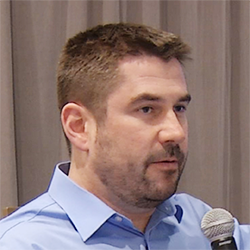Home » Dysautonomias » Organization of the Autonomic Nervous System
Organization of the Autonomic Nervous System
In this video Dr. Goldstein explains how the autonomic nervous system is organized including a discussion introducing sympathetic and parasympathetic chemical messengers.
Now we’re going to talk about how the autonomic nervous system is organized in the body. Well, there are different chemical messengers. We talked about epinephrine, or adrenaline, as the chemical messenger of the sympathetic adrenergic system. Norepinephrine as I just mentioned, or noradrenaline, which is like adrenaline’s father in the catecholamine family, is the main neurotransmitter of the sympathetic nervous system responsible for cardiovascular regulation. And from now on, when I say SNS, I’m not talking about sympathetic nervous system anymore. I am going be talking about sympathetic noradrenergic system. And there’s a third chemical messenger of the sympathetic cholinergic system where acetylcholine is the chemical messenger. So, there are three chemical messengers in the sympathetic nervous system.
And here’s…I’m beginning to get out how this is organized in the body. The sympathetic nerves are mainly postganglionic…post ganglionic… and now you know what postganglionic means, that means wispy, small, slow conducting fibers. With one exception which is the supply to the adrenal medulla. The nerve that’s going to the adrenal medulla, splanchnic nerve, goes through the ganglia without synapsing – that means that the adrenal medulla is receiving myelinated rapidly conducting fibers and teleologically the kind of makes sense in a fight-or-flight kind of situation. By the way, Cannon introduce that phrase, “fight-or-flight.” In a fight-or-flight situation, you want to react fast, so you want that hormone released rapidly and teleologically it’s kind of fun to think about the advantage of having a myelinated innervation of the adrenal medulla.
This is an overview of the sympathetic noradrenergic system. Norepinephrine is the chemical messenger that’s released. It binds to specific receptors which we’ll get into called alpha and beta. The sweat glands receive alpha, have alpha adrenal receptors on their postganglionic sympathetic nerves and there’re both alpha and beta receptors in other organs including the heart.
So, as I mentioned, now we’re going to get into what the chemical messengers are that correspond to these five components. Eventually, as you’ll see, this is going to be key for kind of a systematic approach to a patient who’s got a dysautonomia.
Adrenaline, or epinephrine, is the chemical messenger of the sympathetic adrenergic system and this is kind of an overview. Adrenaline is a hormone, so it’s released into the bloodstream and it’s swept to a variety of organs around the body, although not to most of the brain. For some reason, there’s an effective blood brain barrier for catecholamines such as adrenaline. So when you’re excited and distressed and you say that’s from adrenaline effect in your brain you’ve got to take into account that it’s got to be more complex than that, because as a blood brain barrier for adrenaline, most of the brain doesn’t ever see adrenaline and if you measure adrenaline levels in brain tissue or in spinal fluid you basically you don’t see any adrenaline.
Now the parasympathetic nervous system has two parts to it. This is…what I’m going to be doing is kind of teaching a concept. It’s been questioned but I am not going to deal with the issues surrounding this idea of how the parasympathetic nervous system is organized. The classic teaching is that there are two parts: the cranial part that means coming from the brainstem (and you remember where the brainstem is, that’s the chewy chocolate center in the Tootsie Roll Pop), and the sacral part from the bottom of the spinal cord (the traditional teaching is that there’re parasympathetic nerves there, too). The chemical messenger of the parasympathetic nervous system is acetylcholine. So, you can see that acetylcholine is a chemical messenger for two parts of the autonomic nervous system: parasympathetic and sympathetic cholinergic system. This means that if you had let’s just say an isolated problem with the ability to make catecholamines, like adrenaline and norepinephrine, you would still have parasympathetic – intact parasympathetic function – that’s getting what that means right now – and you would still be able to sweat because of the intact sympathetic cholinergic system.

Wolfgang Singer, MD
Associate Professor of Neurology
Mayo Clinic Rochester, MN































